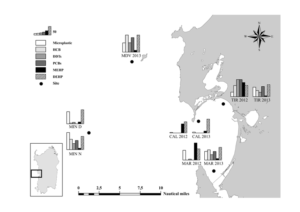Recent international Directives and Conventions on environmental issues emphasise the importance of the protection of marine ecosystems (e.g. Habitats Directive, Barcelona Convention, Water Framework Directive, Marine Strategy Framework Directive). The efficiency of the actual protection measures may be limited by the lack of proper information regarding the biology and ecology of marine species, or the distribution of populations and variability of habitats.
The “Marine Ecology and Conservation” team’s research activity is applied to the conservation of marine protected species and habitats, with the aim to support the application of common management strategies by national and international networks.
Actually, the activities of the research team are mainly focused on Pinna nobilis, Patella ferruginea, sea turtles and marine mammals. Research and monitoring activities on these species include aspects of biology, ecology, spatial distribution in relation to habitat characteristics, population genetics (in collaboration with the Anton Dohrn Zoological Station, Naples), risk assessment and analysis of the efficacy of management strategies. In the IAMC-CNR Institute of Oristano, is also present the CReS – Rescue Center of the Sinis – for the hospitalization of injured sea turtles, mainly belonging to the species Caretta caretta (for additional information please visit the relative web page at: http://www.areamarinasinis.it/it/attivita/cres-centro-di-recupero-del-sinis/index.aspx?m=53&did=1665 ) The activities of CReS are conducted in collaboration with the “Penisola del Sinis – Isola di Mal di Ventre” MPA. The Rescue Center is an important node of the Sardinian Regional Network for the rescue of the marine fauna, instituted in 2004, aimed at improving the conservation strategies of the Mediterranean populations of sea turtles and marine mammals, using the methods exposed in the Italian National Guidelines (ISPRA Manuals and Guidelines 89/2013).
The “Marine Ecology and Conservation” research team also conducts surveys for habitat mapping and analyses of the conservation status of related biological communities.
Recently, the research team has also begun research activities regarding the effects of plastic litter on marine ecosystem. More specifically, these research lines are investigated:
- Analysis of litter-biota interactions (bio indicators considered: sea turtles and planctivorous fish);
- Quantification, characterization and distribution of beach litter;
- Distribution and effects of microliter in the water column.
 |
| Spatial distribution and shell orientations of Pinna nobilis in relation to direction and speed of bottom current. |
 |
 |
| On the left side, a sea turtle Caretta caretta equipped with a Pop Up and TDR sensor is freed. The right side of the picture shows a diving profile (space-time diagram) of a C. caretta: bottom wiggles oscillations are present, indicative of feeding activity in proximity of the bottom (depth -11 meters) |
 |
 |
| On the left side, micro plastic sampling with a “Manta Trawl” net (conducted on the CNR research vessel “Minerva”). On the right side, distribution of micro-litter and related pollutants in the area of Oristano. |
Collaborations
Universidad de Sevilla
University of Bristol
Università degli Studi di Padova
Università di Siena
Stazione Zoologica Anton Dohrn di Napoli (SZN)
Consejo Superior de Investigaciones Centificas – CSIC (Spagna)
Fondazione IMC-Centro Marino Internazionale
ISPRA
Area Marina Protetta Penisola del Sinis-Isola di Mal di Ventre Sinis
Area Marina Protetta di Tavolara – Punta Coda Cavallo
Area Marina Protetta Isole Pelagie
Area Marina Protetta di Capo Carbonara
Area Marina Protetta di Capo Caccia
Parco Nazionale di La Maddalena
Groupe Tortues Marines, France





